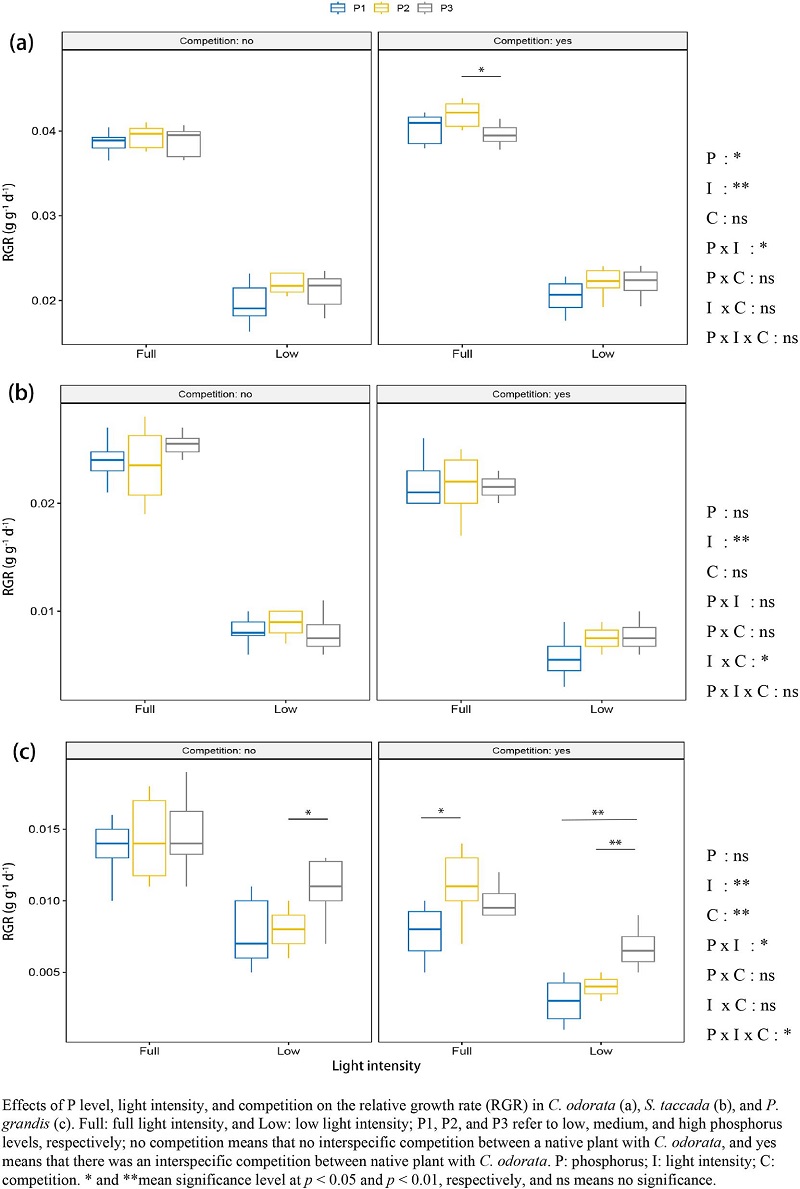High Soil Phosphorus Content Reduce the Competitive Ability of the Invasive Plant Chromolaena odorata in Tropical Coral Islands
Alien plant invasion results in severe socioeconomic and environmental damage worldwide. The negative effects of invasive plants on islands are worse than those on the mainland. Chromolaena. odorata is one of the most common invasive plant species in the world. It is currently one of the main invasive plant species in the Paracel Islands, and caused substantial harm to the native vegetation and ecosystems. However, the effects of soil phosphorus content and light intensity on the competitive advantage of C. odorata and the native species Pisonia grandis and Scaevola taccada in tropical coral islands is still not clear.
In this study, we conducted a greenhouse experiment with two light intensities and three levels of soil available P content, to investigate the effects of soil phosphorous content, light intensity and competition on several physiological traits of C. odorata and the native species. The results showed that low light intensity significantly inhibited the growth of the three species. However, the high P treatment significantly inhibited the growth of C. odorata and significantly increased the growth of S. taccada under full light conditions. The soil P promotes the growth of C. odorata within a certain range of low to medium P levels but inhibits its growth when a threshold P level is exceeded, especially when it is planted with S. taccada or P. grandis. The effect of soil P content on the interspecific competition among C. odorata, P. grandis, and S. taccada was mediated by light intensity and species combination. The high P treatment significantly reduced the competitive advantage of C. odorata over P. grandis.
This study suggests that shaded habitats with a high soil phosphorus content could restrict plant invasion by C. odorata in tropical coral islands. The invasiveness of C. odorata in tropical coral islands can be reduced by protecting native vegetation and thus increasing shade and soil P content. This study also provides a scientific basis for the subsequent ecological restoration and protection of local vegetation and ecosystems on coral islands.
This paper has been published in the journal of Biological Invasions. Graduate students Luping Huang and Mengchen Liao from the research group of Vegetation and Landscape Ecology of South China Botanical Garden, Chinese Academy of Sciences are co-first authors, Professor Shuguang Jian is the corresponding author.
Links to mentioned paper: https://doi.org/10.1007/s10530-023-03186-1
First author information: Luping Huang: PhD candidate, Research Center for Ecology and Environmental Sciences, South China Botanical Garden, Chinese Academy of Sciences, Research field: Restoration ecology and island ecosystem, E-mail: Lupinghuang2019@163.com ; Tel : 020-37252585.
Corresponding author information: Shuguang Jian, Professor, Research Center for Ecology and Environmental Sciences, South China Botanical Garden, Chinese Academy of Sciences, Research field: Restoration ecology and vegetation ecology, E-mail:jiansg@scbg.ac.cn ; Tel : 020-37252585.

Figure. The relative growth rates (RGRs) of the plants under different light intensities and soil available phosphorus conditions.
File Download: